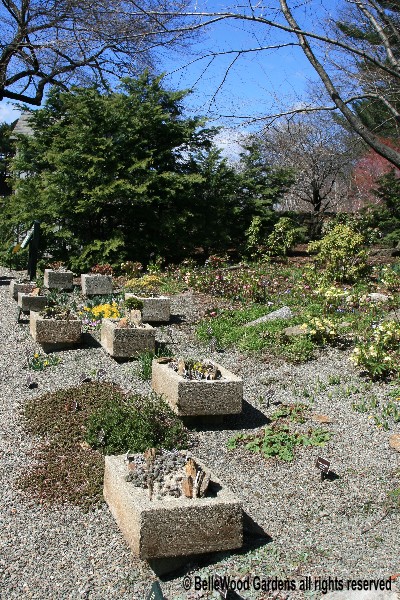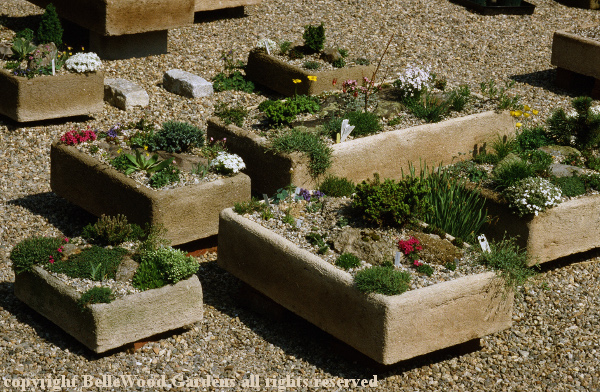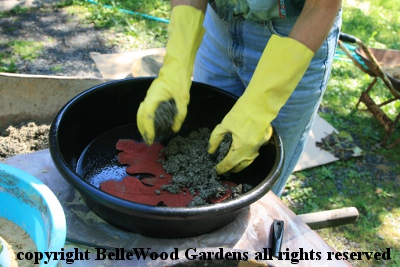.
Garden Diary - February
If you have any comments, observations, or questions about what you read here, remember you can always Contact Me
All content included on this site such as text, graphics and images is protected by U.S and international copyright law.
The compilation of all content on this site is the exclusive property of the site copyright holder.
February
Hypertufa Troughs
Saturday, 10 February 2024
Up in the mountains, well above the tree line, grow astonishing plants. The soil is very mineralized, hardly any organic matter, and the growing season is brief, wedged between snow melting and soon returning.

One August in Colorado, up over Black Bear Pass (12,800 foot elevation) we find Hymenoxis grandiflora.
The soil, should you care to call it that, is an amalgam of small pebbles and larger stones. Such plants
are defined as alpines: plants native to mountain districts, often suitable for growing in rock gardens.
Bring them down to lower elevations and alpines often struggle. Summers are too long a growing season, too hot, soil to rich, too much rain. Alpines rot. Try a container, either for an individual plant or for several, with a specialized lean soil with grit and sand and pebbles, free draining and low in nutrients. But what to use for an aesthetically pleasing container.
There was a time, across the pond in the UK, when farm animals were provided with water in stone sinks.
These were replaced with metal stock tanks, available in a diversity of sizes, easily drilled for drainage.

And rock gardeners happily began using these very heavy stone sinks for alpine plants.
Rock gardeners are very pleased with tufa, a soft, porous calcium carbonate rock. Ilion Gorge, New York is renown as a place where tufa is readily available. Friends have made forays, happily buying large, very large, stones, rocks, boulders that they have hand selected. If, however, this is not an option, consider hypertufa. Hypertufa is, like pottery, maleable, a material that can be shaped.

Hypertufa is made of 2 parts Portland cement, 3 parts perlite, and
3 parts screened peat moss. And of course, water. It would be nice
to find an environmentally better, kinder, alternative for peat moss.
It can be made into troughs, which are popular in rock gardens.

Delaware Valley NARGS display one year, at the Philadelphia Flower Show. And
just so you know, NARGS stand for the "North American Rock Garden Society"

At the Everett Rock Garden of the New York Botanical Garden

Troughs at Olivers Nursery in Fairfield, Connecticut. Lori Chips, alpine manager at the nursery, wrote
Hypertufa Containers: Creating and Planting an Alpine Trough Garden, published by Timber Press.

And then there is the Watnong NARGS chapter in New Jersey. Their annual plant sale
might also have available (if you are lucky) a selection of troughs made by members.

Troughs may be made upside down, formed over sand-covered bowls to create space.
Or, the trough may be formed as a one off, with two cardboard boxes, one up, one down.
 \
\
Wet hypertufa soften the cardboard. Wet cardboard is soggy and flops about.
Tape the boxes before filling and packing / tamping the hypertufa. After that
wrap the immature, "green", trough with plastic so it may slowly cure and set.
In February, the Watnong NARGS Chapter hosted an excellent zoom presentation by Brian Coleman, one of its members. Brian Coleman explained how being an artist and a gardener has led to a two-decade long passion for making hypertufa containers. Brian shared his hypertufa recipe, along with a variety of hypertufa molds and the resulting planters. He also discussed his planting mix and strategies for successfully growing alpine plants in hypertufa troughs. Subsequently, the talk was made a Youtube presentation, allowing for repeated viewings permitting study of the many informative details. Here are a few highlights that Brian graciously gave me permission to include in this entry.

images courtesy Brian Coleman all rights reserved
One advantage of wooden molds is that identical troughs may be cast. Also, their form
is crisp, with clean sides and edges. Feet, to improve drainage, may also be integrated.
Fascinated by a sarcophagus at the Cloisters in Fort Tyron Park in New York City

images courtesy Brian Coleman all rights reserved
Brian cast one for himself out of hypertufa. The mold's form was complicated,
as was removing it. Apparently, there was a will, and this artist found a way!

images courtesy Brian Coleman all rights reserved
Brian also described the soil mix he uses for alpine plants, and the simple tools.
As well as larger troughs for multiple plants, Brian makes smaller, simple troughs for

images courtesy Brian Coleman all rights reserved
individual cacti and agave. These tube molds, ring molds, cylinders are 12 inches in diameter
with 8 inch interior planting space. He assembles them along the driveway during the growing season.

They are light enough to easily move to a west facing unheated porch
where the plants are easily kept safely dry over the winter.
A number of years ago the Tohickon Garden Club, across the river in Bucks County, Pennsylvania, was casting hypertufa for their plant sale. Not sure if this is something they still do currently. I suggested that we cast some leaves. All that's needed are large leaves with prominent veins - rhubarb, big hosta, and such.

Use some form of mold release to coat the inside of the pan.
Lay leaf, veining upermost, centering it in the pan. Note:
another option is to make a sand mound first, to cup leaf.

If desired, coat leaf with a thin layer of concrete pigment
before topping with hypertufa mix. This will tint the casting.

Not a planter. Consider it a decorative item for the garden.
Perhaps call it a bird bath . . .

Another decorative hypertufa creation. Use a fluted plastic bowl
to cast a top that fits a separate column and voilà, a mushroom.

images courtesy Brian Coleman all rights reserved
Let us suppose you admire the concept but not the alpine plants that grow on rocks.
No matter. Brian has a lovely weeping hemlock that is enhanced by a trough of its own.
Why troughs? As Brian points out they are semi-portable (his gothic hypertufa sarcophagus is not easily shifted about. It is, after all, 34 inches long.) He feels that troughs are especially suitable for plants that require a specialized soil mix. And, they elegantly display the plants.
Did you ever make mud pies as a child? Here's an adult version. Have fun!

Back to Top
Back to February
Back to the main Diary Page








 \
\










